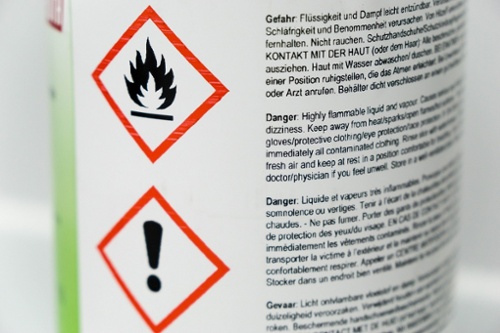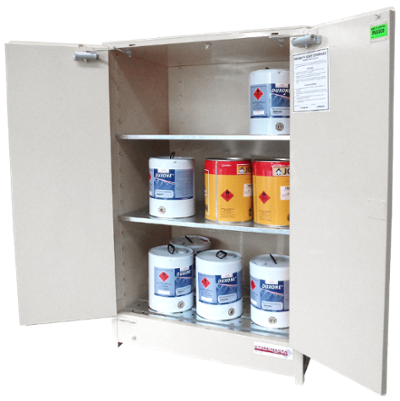Considering how to use and store cleaning chemicals is just part of the job for many Australian businesses. With the heightened importance of proper sanitation and regular cleaning in the workplace, almost every organisation will have at least a few containers of chemicals on hand. While chemicals are needed to maintain a clean, healthy site, many of these products are classed as dangerous goods. Most hospital-grade disinfectants, mould removers and other cleaning products are recognised as having toxic and/or corrosive properties. So, how can you keep your business safe and sanitary while managing your cleaning chemicals supplies? In this blog, we’ll be looking at the hazards associated with cleaning chemicals. We’ll also be highlighting key steps that you can take to ensure that these everyday products are handled and stored in a way that reduces chemical risk.
Common Types Of Cleaning Chemicals
Whether you’re removing grease from machinery or wiping smudges off your office windows, you’ll require a cleaning chemical to help you get the job done. There are many types of cleaning chemicals that may be present in your workplace, such as:
- Bleach
- Bathroom or toilet cleaners
- Chlorine
- Degreasers
- Disinfectants
- Drain cleaners
- Floor cleaners
- Glass cleaners
- Multipurpose cleaners
- Oven cleaners
- Sanitisers
There are countless cleaning agents on the market, with many of these products requiring care and consideration due to their harmful chemical properties. And while there are some non-hazardous cleaning products, such as citric acid, vinegar or baking soda, most businesses rely on chemical cleaners to provide their staff and customers with a hygienic environment.
/Storing%20Cleaning%20Chemicals%20in%20your%20workplace-343222-edited.jpg?width=500&name=Storing%20Cleaning%20Chemicals%20in%20your%20workplace-343222-edited.jpg)
Most cleaning chemicals used in the workplace have caustic, toxic or flammable properties.
Determining The Hazards
When you’re ordering any type of hazardous chemical for your workplace, you must be aware of the chemical class of that particular product.
Cleaning products may be acidic, caustic, toxic and/or flammable — so understanding the class of chemical is important for the safe handling and storage of your cleaners.
Each chemical class will have its own unique set of hazards, such as being prone to ignition, cable of combustion, toxicity or even reactivity. These hazards will also differ in severity and type depending on the specific cleaning product that you’re using.
The first step in chemical safety, whether you’re carrying cleaning products or any type of hazardous substance, is to access the Safety Data Sheet (SDS) of your products. This document will help you determine how the chemical can pose risk to the people, property and environment of your organisation.
We’ll now go into detail now about the potential hazards these products can pose if your cleaning chemicals aren’t handled or stored in a safe manner.
IMPORTANT: You should always study your SDS for every chemical that you have onsite. Your SDS will detail the dangerous goods class of the product, as well as explain the hazards of the chemical. The SDS will also detail the chemical hazard prevention and response requirements that should be incorporated into your operational procedures.
Types Of Chemical Hazards
When you’re working with any type of hazardous chemical or dangerous good, there are three main types of hazards.
These include:
- Human harm – chemical burns, asphyxiation, eye damage, blindness, poisoning
- Property damage – ignition, explosion, corrosion
- Environmental contamination – toxic contamination of soil, land, animals or wildlife
A chemical, such as bleach, is categorised in Australia as a dangerous good. Used as a universal bleach for disinfecting surfaces, it may be manufactured as a mixture of liquid chlorine bleach and sodium hypochlorite.
This mix of chemicals is recognised as being a hazardous substance, with the potential to cause skin erosion (chemical burns from spilled liquids), eye damage (if splashed into eyes of workers) and acute aquatic toxicity (when entering the environment).

There are many health hazards associated with the misuse of cleaning chemicals such as eye damage, breathing problems and chemical burns.
Therefore, liquid chlorine bleach must be handled and stored in a way that prevents the chemical from:
- Making contact with the skin or eyes of staff
- Hazardous vapours building up and affecting the breathing of workers
- The liquid reaching soil, water or the outdoor environment
Each chemical will have its own set of hazards, so you must refer to the SDS and strictly follow the advice provided by the chemical manufacturer.
REMEMBER: You’re required to request an SDS for each hazardous chemical that you have onsite. It’s also a requirement that you make the SDS available for all relevant staff (and emergency services in the event of an incident). We suggest using a dedicated SDS folder and placing it in a document box attached to your chemical stores.
Understand The Level Of Risk
While your SDS will detail the potential hazards associated with your particular cleaning product, you must then apply this knowledge to your own workplace. Conducting an onsite risk assessment is an important step in being able to handle and store your hazardous cleaning chemicals whilst meeting your compliance obligations.
During your chemical risk assessment, consider the following points:
- Where are the hazardous chemicals used or stored?
- How are these substances handled, dispensed or transferred throughout the workplace?
- Have there been any incidents which have been linked to your cleaning chemicals?
- What are the other hazards at the worksite, such as incompatible substances or ignition sources?
Once your risk assessment is complete, you can then create procedures and implement measures to ensure that the cleaning chemicals are handled and stored in a manner that controls the hazards.
Practice Safe Handling
Referring to your chemical’s SDS will give you the basic information that you require about the preventative measures required to reduce human harm (and other hazards).
Some basic guidelines for the handling of cleaning chemicals may include:
- Only using hazardous chemicals in a well-ventilated space
- Ensuring staff are dressed in the appropriate PPE, such as gloves, eyewear and protective clothing
- Inspecting and maintaining PPE to ensure sufficient protection
- Providing chemical safety training for all staff who are using or storing these hazardous substances
- Prohibiting unauthorised use of any hazardous substances
- If flammable liquids, combustible liquids or oxidizing agents are used at your site, make sure that there are no ignition sources in handling or storage areas
- Practice chemical segregation in all handling and storage areas
- Keep chemical containers clearly labelled, with the lids tightly on
- Only use decanting equipment that is fit-for-purpose
- Clean-up any leaks or spills with a compliant spill kit
- Make sure that rags, mops and additional cleaning equipment are only used for that particular chemical product
Install and Maintain Chemical Cabinets
Whether your organisation is carrying multiple IBCs of cleaning chemicals or just a few containers of disinfectant, it’s important to keep your hazardous substances in a compliant cabinet or store. Selecting appropriate chemical storage is a key factor in risk reduction, but you must choose an option that is specifically designed to house the dangerous goods class that you’re carrying.
Chemical cabinets are generally used for the storage of hazardous chemicals indoors, while outdoor chemical storage containers are suitable for larger quantities of chemicals in drums or IBCs. For many organisations, an indoor chemical cabinet will be sufficient in capacity to adequately store their supplies of cleaning products.
REMEMBER: Many hazardous chemicals require certain conditions for safe storage, such as not being kept in extreme cold or heat — or being stored away from direct sunlight. Always make sure that your cleaning products are stored in an environment that reduces the opportunity for risk.
There are a variety of hazard controls constructed into a compliant chemical cabinet. These include a liquid-tight spill sump to contain any leaks or spills that may occur within the cabinet. Many chemical storage cabinets are also constructed from durable double-walled sheet steel, which provides hazardous vapour containment and impact protection, as well as a thermal barrier in the event of a workplace fire.
Selecting a compliant chemical cabinet for your cleaning products will require the determining of the dangerous goods class of chemical — as well as the quantity of product that you’ll be storing. For example, if you’re storing a toxic cleaning product, you’ll need a toxic chemical cabinet that can comfortably fit the aggregate volume of chemicals that you’re carrying.

Your toxic cabinet will be specifically constructed to reduce the hazards associated with Class 6 Toxic Substances.
While compliant storage and careful handling of hazardous chemicals are essential for workplace health and safety, it’s also important to regularly inspect, clean and maintain equipment to reduce chemical risk.
Your cleaning products should also be stacked, loaded (not overloaded) and handled in such a way that reduces the likelihood of leaks and spills. Remember to ensure that all hazardous vapours emissions are limited through the provision of adequate ventilation as well as the cleaning down of chemical containers and equipment. An important part of establishing a sound housekeeping routine is to regularly inspect the cabinet and promptly remove any chemical waste that is contained within the spill sump.
How Are You Storing Your Cleaning Chemicals?
While cleaning products are a necessary chemical for many workplaces, these hazardous substances must be used and stored in a manner that minimises hazards. Incidents such as spills, ignition or harmful vapours emissions can harm your staff, your business and even the wider community. By understanding the properties and hazards associated with your cleaning chemicals, you’ll be able to implement and maintain safe handling and storage procedures.
To find out more about installing and maintaining chemical cabinets, why not access our free eBook? Essential Considerations When Storing Flammable Liquids Indoors will help you understand your compliance obligations if your business is carrying flammable cleaning chemicals or any Class 3 liquids. Grab your copy for free today to learn more about reducing chemical hazards in your business.
Joining the team as a Dangerous Goods Storage Consultant, Melissa Hampton became Storemasta's Marketing Manager in late 2021. With extensive knowledge and experience in chemical compliance, Melissa is responsible for leading the Marketing team and helping shape their marketing strategy. In her spare time, you can find Melissa hiking, swimming and enjoying the great outdoors in beautiful north-west Tasmania.
